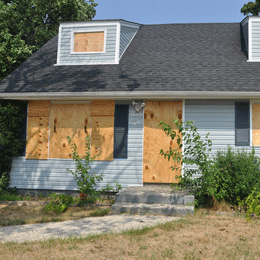
First it starts with the overgrown grass. Then it’s a hanging gutter, knocked loose in a storm. Next come the animals, the kind that find their way inside through any small opening and multiply quickly. And then there’s the vandalism like graffiti or smashed windows, or the criminals who come to deal drugs or steal copper piping to sell.
These are the signs of a zombie home. Homes that have been empty for years, mired in the foreclosure process, and neighbors none too pleased to watch them deteriorate before their eyes. Like a Cherry Hill resident who had to set traps for the raccoons and opossums that had overtaken the house next door after years of vacancy. Or a family in Haddonfield who had to spend their own money for tree removal from the vacant twin with which they shared a lot. Zombie homes pose a threat to the safety of neighbors and the property values of the neighborhood as a whole and they are all over South Jersey.
The state of New Jersey ranks No. 1 for vacant “zombie” foreclosures, according to the May 2016 U.S. Residential Property Vacancy and Zombie Foreclosure Report13 from RealtyTrac. New Jersey was found to have 4,003 of these properties, followed by New York (3,352) and Florida (2,467). By comparison, Pennsylvania was found to have only 572 zombie homes. Specifically in South Jersey, Gloucester County had the fewest (237), Burlington County fell in the middle, with 468 zombies, and Camden County showed a year-over-year decline in zombies, although it still had the most foreclosures and zombies (563) of the three counties.
Understandably, South Jersey towns and municipalities have been burdened with the management and upkeep of these properties, from fielding complaints from residents to hiring maintenance crews to handle landscaping. But frustration mounted as town leaders shouldered the burden while banks sat on properties, spurring many of them to band together and find solutions.
Understanding the cause
One might wonder why these homes are vacant at all. Once a homeowner forecloses, shouldn’t the house go right back on the market? Not exactly.
New Jersey’s foreclosure process is one of the longest in the country. According to John Rothamel, a real estate attorney with Rothamel Bratton Law in Haddonfield, the average turnaround time from when a bank forecloses on a home and takes back the title can be two to four years, sometimes six to seven.
“The banks are slow to process foreclosures, plus in New Jersey, it’s an attorney state, which means all foreclosures go through the court system, making it longer than most other states,” he says. “During that time, the previous owner may have already moved out, and this extended time span leads to more deferred maintenance on properties. Signs go up on the house’s windows, utilities are shut off and general land maintenance is not going on. It’s a nuisance in the neighborhood.”
Many times, the previous owner does not even realize the home is being neglected. “Our clients have surrendered their property in the hope that the bank will process it promptly,” says Ellen McDowell, a bankruptcy and real estate attorney with McDowell Posternock Apell & Detrick, PC in Moorestown. “The longer it takes, the more likely there will be problems.” She recalls one client who had rental properties and surrendered them when he filed for Chapter 13 bankruptcy. Four years passed and the bank hadn’t fore- closed, then someone tripped on the sidewalk and sued him for damages.
“People are moving out, looking for normalcy, but homes are sitting there still in their names,” she says.
With the issue as pervasive as it is, banks—as a result of the recession— have too many properties, more than they can manage. As these properties become eyesores, townships pick up the slack, sending maintenance crews regularly, costing hundreds of dollars and billing banks but not always receiving payment. Eventually, lawmakers in Trenton took notice.
Taking action
In 2014, a bill was passed giving municipalities authority to impose fines and citations on creditors that failed to maintain these vacant properties. Fines for in-state creditors were set at a min- imum of $1,500 per day, and out-of- state creditors $2,500 per day.
While this was a big step, townships still had trouble identifying which properties were truly zombies.
A unique partnership formed among several towns in Camden County and several graduate students at Rutgers University-Camden. Together, they helped identify the homes around Haddonfield, Collingswood, Audubon, Pennsauken, Haddon Township, Oaklyn and Camden’s Fairview section. In 2014, their list amounted to about 600 vacant properties. This helped give the towns some leverage when approaching banks.
“We found that if we had two or three properties from bank ‘x’ they weren’t going to pay attention,” says Haddonfield Mayor Jeffrey Kasko. “But if we banded together and showed that their bank collectively had 40 properties in our area sitting vacant and becoming eyesores, then that would get their attention.”
Armed with this knowledge, the towns then started creating their own ordinances to keep track of these properties as they popped up. Cherry Hill, Pennsauken, Washington Township, Moorestown and Collingswood are just some of the areas that have started these registries. And Gloucester County as a whole has followed suit.
In Cherry Hill, property mainte- nance officers would visit vacant properties to cut the grass, costing $250-$500 each time. Their regulations require owners to register their homes and designate some- one to handle code violations. The fees escalate year by year, from $500 to $5,000 in the third year.
Pennsauken’s ordinance requires owners to register their properties within 30 days of becoming vacant, according to Frank Sinatra, Pennsauken Township spokesman. The fee also escalates: $500 for the first year, $1,000 for the second, and $1,500 for the third.
“In general the financial institutions are responsible for registering with the township and we have been successful with it,” says Sinatra. “We’ve registered close to 180 houses, but the number changes. The ordinance does two things for us: it identifies the property and the bank management team responsible for maintaining the property.”
Washington Township has also made headway in its zombie homes through an ordinance. “Like any other community we’ve been affected by numerous foreclosed homes,” says Robert Smith, Washington Township’s business administrator. “Problems we’ve seen range from homes with siding damage or an overgrown lawn, to a broken fence and a pool, which poses a hazard for children in the neighborhood.”
Smith says they hire a contractor to cut the lawns on these properties and if the responsible party can’t be identified, the township has a cut and lien program. “We’ll file a lien on the property and when that property is sold, the lien must be satisfied,” he says. But the ordinance is also working as he reports that the township has collected over $200,000 in fees directly from lenders as of the end of this past February.
“The fees from this ordinance offset the administrative costs of managing these homes, which means fortunately not too much tax money is being spent on [maintaining] these homes,” he says.
Moorestown’s ordinance took effect last year and Mayor Phil Garwood says 21 homes were immediately registered on it. This year, 15 of those 21 renewed their registration, and 12 new properties were added, totaling 27.
“One thing we’ve been most surprised to find was how these properties start switch- ing banks,” Garwood says. “This ordinance gives us some leverage to get a hold of them and keep the owners responsible for the property. It’s a problem across the area and we’re just trying to get a hold of it.”
From her clients’ perspective, McDowell adds that these fees are an undue burden. “Municipalities are fining these homeowners for properties they haven’t lived in for years. You have a person going through bankruptcy [with] no money who is now being asked to pay these fines all because the banks are dragging their feet,” she says.
Turning things around
While the fees and lists help with the maintenance aspect, there seems to be a larger goal in mind all across South Jersey: getting these homes back on the market.
“What matters most to us,” says Haddonfield’s Kasko, “is for the home to be occupied.”
Sinatra says this is Pennsauken’s No. 1 priority.
“We’re doing the best with the tools out there to manage the issue,” says Tracey Howarth, whom the township hired specifically to manage the housing issue. She is currently compiling information about the vacant homes in town. “We’re starting from the bottom and seeing where we stand and building partnerships with the Housing and Community Development Network of New Jersey and St. Joseph’s Carpenter Society.”
She says that St. Joseph’s has been given the opportunity to go around Pennsauken and see if there are homes they want to renovate. “They’ve already started working on one and others are interested in negotiating and buying to fix up and resell,” Howarth says.
Rothamel says he works with many investors who are waiting to get their hands on these types of properties. “We’ve seen a lot of houses rehabbed already in the Haddon Avenue corridor in Collingswood and Haddon Town- ship,” he says. “Some of these homes hadn’t been renovated in 40 years, and now they are getting fresh, clean and modern looks and becoming the nicest homes in the neighborhood. They improve the value of the community and become the new comps by which other homes will be valued and bring buyers back into the market.”
The Burlington Camden County Association of REALTORS (BCCAR) has worked with several communities to share information about these properties and maintain stability in neighborhoods.
According to Michelle Arnold, Realtor and BCCAR legislative committee chairperson, 2016 is shaping up to be a strong year for residential real estate. “From a realtor’s perspective we are seeing more properties moving along the process and a push to get new families in there,” she says. “We feel it’s not as bleak as some of the studies show because there is a real effort on the local and state level to get these properties back on the market. We’ve had more homes sold year-to-date in 2016 than this time in 2015.”
Foreclosure is never a good situation for any family or community, and town- ships are doing what they need to do to manage the issue, while also inform- ing homeowners that there are other options. “We want to communicate with residents that there are resources available if they find themselves under water,” says Sinatra. “Programs that can help them stay in their homes, and we’d like to keep them there.”
Pennsauken will be presenting options from the Housing and Community Development Network on their website, through social media and in print.
“For a homeowner, foreclosure is the worst case scenario,” says Rothamel. “There are options to preserve your financial future and get out of the situation before years of neglect ruin the home and burden the community.”
Published (and copyrighted) in South Jersey Magazine, Volume 13, Issue 3 (June, 2016).
For more info on South Jersey Magazine, click here.
To subscribe to South Jersey Magazine, click here.
To advertise in South Jersey Magazine, click here.












